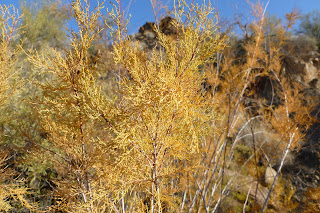Thursday, December 22, 2011
First encounter with the Sonoran
After dragging our carbon feet across miles that would take days on a loaded bicycle, we entered the Sonoran Desert, which is much different in character from the Mojave. Much of the Mojave is higher, but it is also drier. By desert standards, the Sonoran is "wet," receiving in many locations about 11 inches of rain a year divided between winter and summer rainy seasons. This moisture coupled with extreme heat give rise to a vast array of amazing vegetables, most notably the iconic saguaro pictured above. These monsters can be thirty feet high and hundreds of years old. The grooves in the arms and trunk are actually pleats, and when the rain is good, the saguaro expands to on-load as much water as possible for the still considerable dry periods. They spread millions of seeds after blooming, but only a tiny fraction take root and grow into the noble cacti that dot the Arizona landscape. They don't occur naturally anywhere outside of southern Arizona and northern Mexico. Many are shot full of holes by desert birds who make their nests safe and sound above the desert floor. My favorite story of shooting a saguaro, however, concerns a drunk redneck who decided a stately cactus was the best target for his hungry shotgun. Blam! Blam! Blam! Mr. Red-in-the-Neck waged battle against the stoic succulent until it had had enough. Battered and blasted, the mortally wounded cactus teetered and fell...right on top of the offending shooter, stout spines and hundreds of pounds of angry green meat that pegged him to the ground, killing him. Don't shoot at cacti, kids, you never know when they might bite back.
We struck out from our quick camp besides a sandy wash and hiked into the hills, bundled against a cold spell still working its way through the state. The dead beast you will see below is a pack rat, a handsome rodent, and he could not have been dead long. A few short hikes in the desert will suffice to show you the middens or piles of debris that these creatures accumulate for their nests, often dragging in all manner of objects from far and wide--cans, bottles, bits of plastic and wood, whatever is at hand. Last year, as Jodi, Django and I were camped in central Nevada, we had one somehow get into our camper. A Battle Royal ensued with me wrapping a towel around one hand and reaching into a cabinet to snag the terrified creature, at one point pinning the tip of his tail under a cabinet door. I failed to catch him. We left the escape route open and were happy to find all clear the next morning. We did, however, have the tip of his tail as a trophy of our rough and tumble encounter. All hail the Rodent King!
The palo verde tree. Note the green bark that photosynthesizes:
The fearsome cholla, teddy bear variety, I think. Don't tangle with these!
Tamarisk, and Asian invader, in autumn glory:
Hiking a desert wash:
The mighty shall fall:
Jodi inspects a rock; Django confirms its volcanic origins (smart dog):
Subscribe to:
Post Comments (Atom)







I am so completely jelous !
ReplyDeleteOn the first couple of years of bike camping deserts, I would take an overnite backpack. For instance to get camped high up on those beatifully formed ridges. Days were extended with sunset then sunsrise. Then a different route to the bike parking spot.
Can't walk a mile now, so I'm learning about BaseCamping with a QUAD .... an analoge to using a motorized camper. The QUAD on day trips substitutes for legs ... at the least I get closer to where wandering would take me.
Thanks
Terry Stankunas
Hey, Terry: Thanks for the comments. You're quad looks fantastic. The main thing is to keep getting out there whenever we are able. I never think a day wandering the desert is a day wasted!
DeleteScott